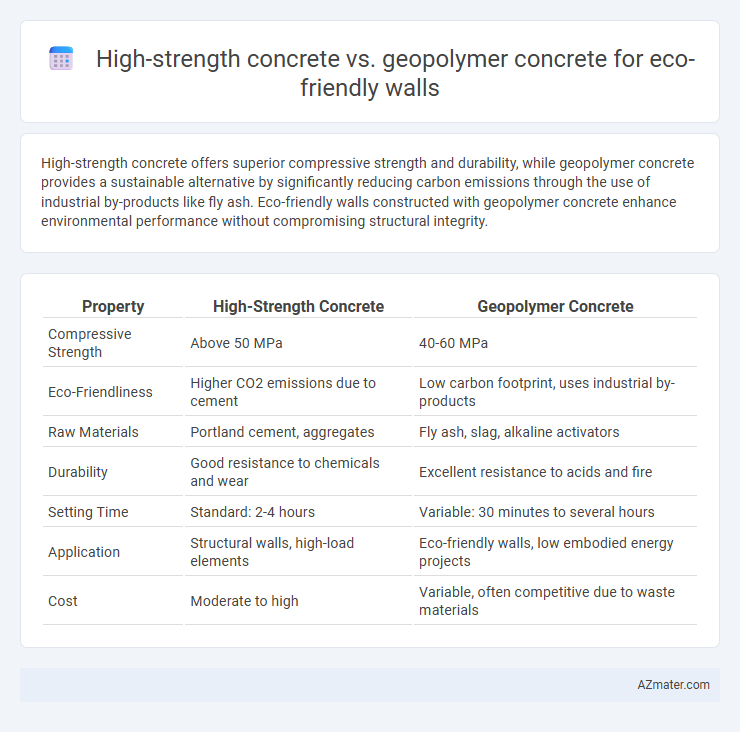High-strength concrete offers superior compressive strength and durability, while geopolymer concrete provides a sustainable alternative by significantly reducing carbon emissions through the use of industrial by-products like fly ash. Eco-friendly walls constructed with geopolymer concrete enhance environmental performance without compromising structural integrity.
Table of Comparison
| Property | High-Strength Concrete | Geopolymer Concrete |
|---|---|---|
| Compressive Strength | Above 50 MPa | 40-60 MPa |
| Eco-Friendliness | Higher CO2 emissions due to cement | Low carbon footprint, uses industrial by-products |
| Raw Materials | Portland cement, aggregates | Fly ash, slag, alkaline activators |
| Durability | Good resistance to chemicals and wear | Excellent resistance to acids and fire |
| Setting Time | Standard: 2-4 hours | Variable: 30 minutes to several hours |
| Application | Structural walls, high-load elements | Eco-friendly walls, low embodied energy projects |
| Cost | Moderate to high | Variable, often competitive due to waste materials |
Overview of Eco-Friendly Wall Construction
High-strength concrete offers durability and load-bearing capacity for eco-friendly wall construction, utilizing Portland cement with optimized mix designs to reduce carbon footprint. Geopolymer concrete, composed of industrial by-products like fly ash and slag, provides low-emission alternatives with superior chemical resistance and thermal insulation properties. Both materials contribute to sustainable building practices, but geopolymer concrete significantly reduces greenhouse gas emissions, making it a preferred choice for environmentally conscious wall systems.
High-Strength Concrete: Composition and Benefits
High-strength concrete (HSC) typically consists of a low water-cement ratio, high cement content, and the inclusion of supplementary cementitious materials like silica fume and fly ash, enhancing its compressive strength above 40 MPa. Its dense microstructure offers superior durability, resistance to chemical attack, and reduced permeability, making it ideal for eco-friendly wall applications that demand longevity and structural integrity. The use of high-strength concrete also enables thinner wall designs, lowering material consumption and contributing to sustainable construction practices.
Geopolymer Concrete: Composition and Advantages
Geopolymer concrete, composed primarily of industrial by-products such as fly ash or slag activated with alkaline solutions, offers superior eco-friendly benefits compared to traditional high-strength concrete by significantly reducing carbon emissions during production. Its excellent thermal stability, chemical resistance, and rapid strength gain make it ideal for sustainable wall construction while minimizing environmental impact. Unlike Portland cement-based high-strength concrete, geopolymer concrete enhances durability and energy efficiency, contributing to long-term sustainability in building design.
Environmental Impact Comparison
High-strength concrete typically relies on Portland cement, contributing significantly to CO2 emissions and resource depletion during production, whereas geopolymer concrete utilizes industrial by-products like fly ash and slag, dramatically reducing carbon footprint and energy consumption. Lifecycle assessments reveal geopolymer concrete lowers greenhouse gas emissions by up to 80% compared to traditional high-strength concrete, making it a superior choice for eco-friendly wall applications. Moreover, geopolymer concrete demonstrates enhanced durability and resistance to chemical attack, extending structural lifespan and minimizing environmental impact through reduced maintenance and replacement needs.
Durability and Performance in Wall Applications
High-strength concrete exhibits exceptional compressive strength and durability, making it suitable for load-bearing eco-friendly wall applications that demand long-term structural integrity. Geopolymer concrete offers superior resistance to chemical attack, high temperatures, and moisture, enhancing sustainability by reducing carbon footprint while maintaining robust performance in harsh environmental conditions. Both materials provide excellent durability in wall construction, with geopolymer concrete outperforming traditional high-strength concrete in eco-friendly, sustainable building projects.
Carbon Footprint: High-Strength Concrete vs Geopolymer
High-strength concrete typically has a carbon footprint of approximately 400-600 kg CO2 per cubic meter due to its high cement content, whereas geopolymer concrete can reduce emissions by up to 80% by utilizing industrial byproducts like fly ash or slag instead of Portland cement. The reduced clinker requirement in geopolymer concrete significantly lowers CO2 emissions during production, making it a more sustainable choice for eco-friendly wall construction. Lifecycle assessments confirm geopolymer concrete's advantage in minimizing embodied carbon while maintaining comparable mechanical properties to high-strength concrete.
Cost Analysis and Material Availability
High-strength concrete typically involves Portland cement, which contributes to higher carbon emissions and fluctuating costs due to cement price volatility. Geopolymer concrete uses industrial by-products like fly ash or slag, reducing environmental impact and often lowering material costs, especially in regions with abundant waste resources. Material availability for geopolymer concrete depends on local industrial waste supply, making it more sustainable and cost-effective in areas with access to these raw materials compared to conventional high-strength concrete.
Thermal and Acoustic Insulation Properties
High-strength concrete exhibits moderate thermal insulation but often requires supplementary materials to enhance acoustic performance, making it less efficient for eco-friendly wall applications. Geopolymer concrete demonstrates superior thermal insulation due to its dense matrix and low thermal conductivity, effectively reducing heat transfer in sustainable building designs. Its inherent porous structure also provides enhanced acoustic insulation, making geopolymer concrete a preferred eco-friendly solution for walls requiring energy efficiency and noise reduction.
Sustainability in Construction Practices
High-strength concrete, widely used for its durability and load-bearing capacity, typically relies on Portland cement, which contributes significantly to CO2 emissions during production. Geopolymer concrete, made from industrial waste materials like fly ash and slag, offers a sustainable alternative by reducing carbon footprint and conserving natural resources while maintaining comparable strength and durability. Incorporating geopolymer concrete in eco-friendly walls promotes sustainable construction practices through lower environmental impact and enhanced longevity.
Future Trends in Eco-Friendly Concrete for Walls
Future trends in eco-friendly concrete for walls emphasize the increasing adoption of geopolymer concrete due to its significantly lower carbon footprint compared to high-strength concrete, which relies heavily on Portland cement. Research focuses on improving the durability and mechanical properties of geopolymer concrete while enhancing its compatibility with sustainable construction practices. Innovations in material science and industrial waste utilization position geopolymer concrete as a leading candidate for next-generation eco-friendly wall applications.

Infographic: High-strength concrete vs Geopolymer concrete for Eco-friendly wall
 azmater.com
azmater.com